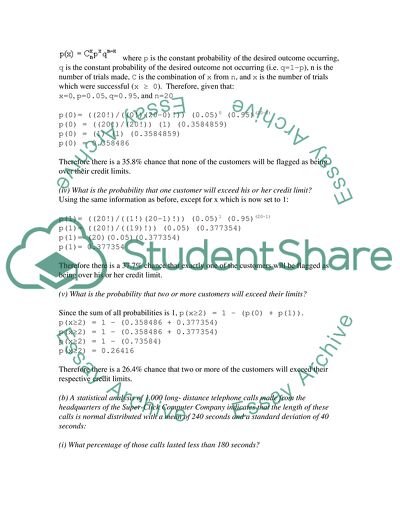
- Home
- Free Samples
- Premium Essays
- Editing Services
- Extra Tools
- Essay Writing Help
- About Us
- Studentshare
- Subjects
- Miscellaneous
- Interim Progress Riew Question 4
Interim Progress Riew Question 4 - Essay Example

- Subject: Miscellaneous
- Type: Essay
- Level: Masters
- Pages: 4 (1000 words)
- Downloads: 0
- Author: ellsworth36
Extract of sample "Interim Progress Riew Question 4"
As the number of trials grows very large, the ratio of the number of successful outcomes to the number of trials will approach some finite limit; this ratio is the probability of the event occurring. Likewise, the variance σ2 is given by the number of trials, times the probability of a customer exceeding the credit limit, times the probability that the customer did not exceed the credit limit (i.e. q = 1-p). where p is the constant probability of the desired outcome occurring, q is the constant probability of the desired outcome not occurring (i.e. q=1-p), n is the number of trials made, C is the combination of x from n, and x is the number of trials which were successful (x ≥ 0).
Therefore, given that: (b) A statistical analysis of 1,000 long- distance telephone calls made from the headquarters of the Super-Click Computer Company indicates that the length of these calls is normal distributed with a mean of 240 seconds and a standard deviation of 40 seconds: Since the call lengths are normally distributed, the question can be answered by finding the appropriate z value to determine the percentage of calls that are between 180 seconds long and 240 seconds long (i.e. the mean).
As the area under the curve between 180 and the mean (240) has already been found, it is necessary only to calculate the amount of area under the curve between the mean and 260 seconds. Following the same procedure as above: To determine the length of the call, it is necessary to determine the appropriate z-value. Since exactly half the calls are less than the mean in a normal distribution, the amount of area between the z-value and the mean must be 0.49 (i.e. 0.5 – 0.01). Looking on a z-table, it can be determined that the corresponding z-value for such an area is approximately 2.
33 standard deviations below the mean.
...Download file to see next pages Read More
- TERMS & CONDITIONS
- PRIVACY POLICY
- COOKIES POLICY